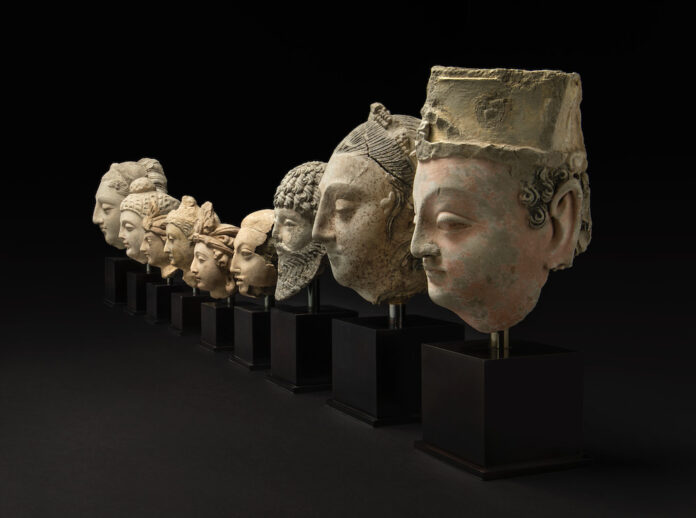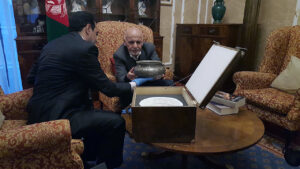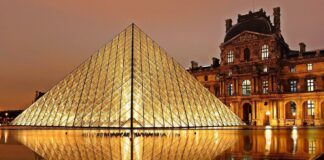
The British Museum’s Senior Curator for the Middle East talks about collaboration with foreign museums, restoring stolen art, and the museum’s role as expert witness to looting by Kate Fitz Gibbon.
Dr St John Simpson is an archaeologist and the Senior Curator in the Department of the Middle East at the British Museum, where his area of oversight also includes Afghanistan, Iran, and Central Asia. For more details have a look at part 1 of the interview.
Kate Fitz Gibbon: What are your working relationships in Afghanistan?
St John Simpson: We work with museums as we are not a university, although we have some PhD students. Museums are our comfort zone. In Afghanistan we work very closely with the National Museum of Kabul. We have so far repatriated just over 2,300 antiquities of all periods seized by law enforcement since 2003 and we’ve developed a very efficient protocol with Kabul. Whenever we are made aware of an object or a group of objects and we are sure that they have come from Afghanistan, we notify the National Museum in Kabul and then they effectively empower the British Museum to act on their behalf. We contact the Afghanistan Embassy in London and we create a report on the objects and we are allowed, if we have got the resources, to scientifically analyze the objects and we are allowed to display them. We have a dedicated showcase for that material. We’ll do a press release jointly, a handover ceremony to the Embassy and they will return the objects to the National Museum. It’s a tremendously successful protocol and it’s now been adopted by several other countries in the Middle East.
Of these 2300 antiquities returned since 2003, can you describe the types?
St John Simpson: We’ve had all sorts from Bronze Age cemetery material from the Mazar i Sharif area, we’ve had pottery from more recent looting down in the south, we’ve had a small number of pieces from the Hellenistic period that may come from Ai Khanoum. We’ve had Islamic metalwork, ceramics, and Gandharan Buddhist material – pretty much a representative range of Afghanistan’s history starting around 2500 BC.
Are there a lot of coins?
St John Simpson: Not very many actually. Coins have been a little bit more difficult to prove where they are from. You may have the place of minting but coins circulate internationally, whether they are of low denomination or high denomination. Unless they are in a consignment where we are very sure that they all come from one place we’ve had limited success returning coins. Non-collected coins of any value – for example silver coins simply get melted down.
How much of it is fake?
St John Simpson: There was some fake material amongst those that we sent back. Because they were mixed consignments, we felt it was appropriate to send it all back and not be the judge as to whether something should stay or not. The decision about the retention policy should be made in Kabul. It’s true that we see far more fakes than genuine artifacts on the market. That’s again something that has been underestimated and under-reported. There’s a huge industry out there producing fakes because it’s much cheaper and much safer to make objects that are complete than it is to hire dozens of workmen to go out into what is potentially a conflict zone and dig and bribe and pay middlemen along a chain. It is unsurprising really on economic grounds why there are so many fakes.
Now, the internet is a perfect platform for the sale of fakes and low-quality material. The buyer cannot see the object except through an image, which may be a poor-quality image, particularly when they are using social media platforms.
It’s not an art trade, it’s a scam.
St John Simpson: It’s fraudulent activity of a different sort. You can’t trace the seller very easily. We’ve been shown images of objects by individuals and organizations where there was good reason to think that these objects were in Syria or had been recently exported from Syria but in every single case when I sat down with somebody and looked at these images they were all fake. The level of disappointment for law enforcement is quite palpable. You’ve got these very serious people hoping to press charges and we say actually all we can tell you is that it’s not genuine. It’s not worth any money, and there is no income stream coming from it.
The objects that I saw in Afghanistan in the 1970s were mostly real. But in Peshawar or in Swat in Pakistan, not only the things for sale in the bazaar, but even the objects in the museums were often fakes. They had been switched out for the real ones.
St John Simpson: There is a story that can trump that one. Claudius James Rich, the political resident in Baghdad at the beginning of the 19th century, went to Babylon and acquired a number of cuneiform tablets. No one could read them. It was almost half a century before anyone could read cuneiform. But because they saw him coming, probably quite literally, at the head of a small cavalry troop, they started to produce fakes. We have as many fakes as we have genuine objects in the Rich Collection at the British Museum, from the beginning of the 19th century.
That’s supply and demand! The media only talks about looted treasures. I suppose they don’t want to disappoint.
St John Simpson: Exactly. But the facts are not as widely reported or recognized as much as they should be. If we can come up with a different angle, in our experience, we will get the story to the public. You asked about James Cuno, and his statements that museums are the best place to really discover an object’s history.
That is an important point that should be made. Museums are for everyone; they are for people of all ages and all backgrounds. Our role is obviously to educate and enlighten but it’s also to surprise people and to bring cultures to life and make every object relevant to that individual.
Knowing where something comes from obviously helps us tell a story but we shouldn’t discount the orphans because they have a part to play too. One of our goals and challenges as museum curators is to wring out from every single object, provenanced or unprovenanced, what its story is and what its relevance is. That is something that is worth emphasizing.
There is material that has come out of Afghanistan over the last forty years of war that hasn’t been discussed in the scholarly world because of its antecedents. Archaeological context is not absolutely required in order to do art history. Some say it’s foolish to close your eyes to this material.
St John Simpson: I do agree. It is easy to classify the world in black and white, but the world is polychromatic in multiple shades. We shouldn’t ever exclude the possibility of getting any information we can from objects. We have scientifically analyzed some of the looted material we had before sending it back to Kabul. We’ve had very specific questions in mind.
For instance, we’ve had some of those little Bronze Age cosmetic jars that often have applicators still in position or traces of the residue. But very few analyses have ever been done or at least published of the cosmetics, so we thought it would be really interesting to take a range of those containers and analyze the contents. We could try to understand what the beauty industry was like in Bactria in the year 2000 BC.
Secondly, we had a group of carved wooden objects. I heard almost as many different interpretations of their age as you could imagine: Bactrian, ethnographic, medieval, and everything in between. We thought, we’ve got permission from Kabul to analyze. There were fragments in the box. So we looked at the wood and then we radiocarbon dated them. When we radiocarbon dated them, it showed that they were carved from wood in the 1990s. They are all modern fakes, but there is now a whole genre of fakes out there, which we have even seen passing through an online auction. Now we can recognize a class of fakes that we had not known about before. And we’ve given that information back to Kabul along with the objects. In a very small way, we have moved the subject forward. Those are two little cases where we have made a little bit of a difference by looking out for orphan objects.
And the amazing stucco heads now at the British Museum?
St John Simpson: We haven’t yet returned them because we are under lockdown. They are fantastic pieces. A couple of crates coming in from Peshawar caught the eye of Border Force at Heathrow. After a long running investigation by the police and Her Majesty’s Revenue and Customs into the importer they were finally disclaimed. That’s when we were able to announce their presence. Polychrome painted stucco heads, bodies probably still in the ground, and a headless bodhisattva of gray schist. It’s clear from looking at the neck that the piece has been beheaded in recent times. It’s not an old break. I wonder whether we’ll ever identify that head somewhere in a different collection one day. That would be an amazing moment. Likewise, I do wonder where the bodies of the stucco heads lie. Are they from an unexcavated part of Mes Aynak? Or from another site somewhere in Afghanistan? They must be somewhere.

Stylistically, what do you think?
St John Simpson: It’s one group, 4th to 6th century. There are some general similarities with the heads from Hadda. But the sites in the Hadda area were looted a long time ago or excavated a long time ago. I think they are much more likely to come from another place and Mes Aynak is an obvious possibility. We don’t know much about what has been found at Mes Aynak apart from what’s in the catalog of the exhibition in Prague and what’s on display at the Kabul Museum. We don’t know what is still unexcavated. It’s a huge complex.
When you have spectacular pieces like the heads, are you able to do 3D imaging so that you would be able to match them later to bodies?
St John Simpson: We are short of capacity for 3D imaging but we did do CT scans of them to try to understand how they were made. We can show graphically how the layers of stucco were applied. And we analyzed some of the pigments, so that we could give that data there to our colleagues in Kabul.
It is always a case of resourcing when it comes to analysis. In an ideal world we’d like to do much more of that, but it has always been a case of balancing the information that we can get from pieces that are not ours against what we should be doing to research our own collection.
Going back to what you were saying about the lack of utility of what is being done with satellite imaging, is the most beneficial use of the technology that is available today to document objects, not holes in the ground?
You can now photograph an object at an archaeological site and send the data to the Cloud with exact GPS coordinates and links to everything found nearby. You can document all objects in museums. It’s not only relevant information, it also means that stolen objects can never be sold, or if they are, you can get them back.
St John Simpson: That’s right. I completely agree. That is one of the lessons we have learned unfortunately several times from recent conflicts; the primary task is documentation of collections. I don’t just mean national museums but local museums and archaeological depots. Those are by definition less well protected than national museums. Document that material with good photographs.
Capture those data and put them in multiple safe places. One gets the impression that there is not enough backing up of the data. We would advocate that much more effort goes into that. That’s a whole area of continuing discussion with countries and museums around the world. It is not for us to advise other museums what to do, but if everyone realizes that’s a vulnerability in the system, then that needs to be addressed.
Where should resources be directed besides training and documentation?
St John Simpson: Those two are important. It’s got to be practical training. One of the things that recently came up with our discussions with our friends in the National Museum in Kabul was a more practical publication of what’s been stolen and what’s been returned. We have the UNESCO publication which is unusable because it mixes up objects which we know are in Kabul, or in international travelling exhibitions, with objects which have been stolen. They are arranged in an academic fashion which makes it very difficult to use if you are not an academic, like law enforcement.
The question posed in Kabul was whether a new publication would be useful, and that would be relatively easy to do. Following on from that, full publication of what is returned and repatriated to foreign countries is very important to make the process transparent. We know of some countries returning large quantities of material to Iraq and to Afghanistan. However, with the exception of what the British Museum has listed and put out through the press, we’ve got very little idea what those objects are. We know that our colleagues in Baghdad and Kabul and other capitals in the Middle East would welcome full publication of objects when they are repatriated for the same purpose. We would then be able to see patterns in the market and start to work more collaboratively across countries, not just Britain and Afghanistan, but maybe Britain and America or with other European countries. We could extend this process we’ve begun of having showcases on repatriation, so that when objects go back they can be seen and appreciated by wide members of the public, and everyone can understand what museums do when they work together.
Transparency would be of huge importance to private collectors and to art dealers too. People who collect art are generally not billionaires with private museums, they are people who are passionate about the works. They feel responsible for them like children and they don’t want to send them off to somewhere where they won’t be cared for. The collaborative building of cultural institutions is absolutely key and if the institutions are respectable places to send your children then the objects will follow. It would enable a whole different level of magnitude of collaboration with museums in source countries. That would be a beautiful world.
St John Simpson: I have emphasized perhaps too much the role we have played in law enforcement. We have worked with private individuals including dealers in repatriations. One private couple bought a bowl in Jeddah decades ago in good faith. This was before passage of Britain’s 2003 law on tainted objects. Many years later they took it to Christie’s where they recognized it as having been published by Souren Melikian-Chirvani as from the Kabul Museum. There were some sensitive conversations to decide the best way forward and the owners did agree to presenting it to Kabul. There was a handover ceremony as we generally do, with the deputy director and legal services, the owners, Christie’s and the Afghan Embassy. Then that night the box was opened in the embassy in London and Ashraf Ghani was there by chance. Ashraf Ghani took it back with him on the plane to Kabul the next day, with Karzai. Our friend in the National Museum got a phone call a few days later from the palace inviting him in person to go and collect it, personally. So the bowl is now on display in the new Islamic gallery in the Kabul Museum. That is a really positive story and heartwarming and beneficial for everyone as well as a challenge to have pulled off.
And the politicians involved will never forget that they played a role.
St John Simpson: Yes. Ashraf Ghani’s face when the box is opened and he is presented with the piece to take back. You should see the picture!
In our archive you can read Part 1 of the interview.
This interview was published originally on Cultural Property News.
Don’t miss to subscribe to their newsletter (on top on the right)!
Recently the RAND report also came to the conclusion that illicit trade in antiquities is not such a big market as media used to depict it.



